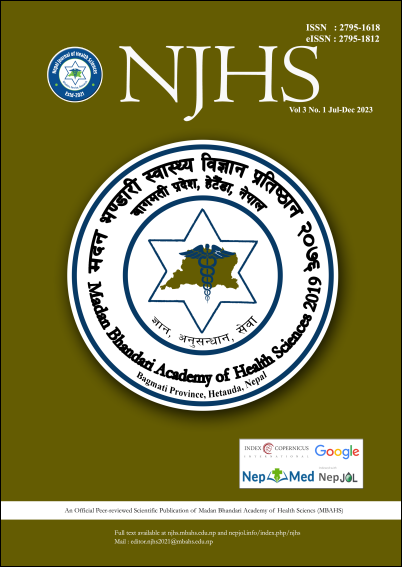Oxidative Stress and Glycaemic Control in Type 2 Diabetes Mellitus
DOI:
https://doi.org/10.3126/njhs.v3i1.63272Keywords:
Diabetes mellitus, glycated Haemoglobin, malondialdehyde, oxidative Stress, total antioxidant capacityAbstract
Introduction: There is growing evidence that excess generation of highly reactive free radicals largely due to hyperglycaemia cause oxidative stress which further exacerbates the development and progression of type 2 diabetes mellitus and its complications.
Objective: This study aims to assess glycaemic status and oxidative stress in type 2 diabetes mellitus patients.
Methods: Forty confirmed Type 2 diabetes mellitus patients registered with the General Medicine department of Mamata General Hospital, Khammam, Andhra Pradesh were selected for the study. Based on HbA1 c levels these patients were subdivided into two groups one with HbA1 c levels >8.5% was considered poor glycaemic control and the other with HbA1 c levels ≤8.5% was considered as good glycaemic control. Malondialdehyde and total antioxidant capacity were measured among the cases and controls.
Results: This study reveals the comparison of glycated haemoglobin, malondialdehyde, and total antioxidant capacity in 40 confirmed cases of Type 2 Diabetes Mellitus, which included 19 good glycaemic control and 21 poor glycaemic control. Firstly, the comparison of HbA1C (P value: 0.01), MDA (P value: 0.02) and TAC (P value: 0.04) revealed the significant difference between good glycaemic control and poor glycaemic control. Moreover, the Pearson correlation revealed a significant positive correlation of HbA1C with MDA (+0.72, 0.02) and a negative correlation with TAC (-0.01, 0.7) which was not statistically significant.
Conclusions: It is observed that poor glycaemic control has resulted in increased oxidative stress and decreased antioxidant capacity which can ultimately lead to complications. Antioxidant supplementation may help the patients in overall improvement and may delay the complications.
Downloads
Downloads
Published
How to Cite
Issue
Section
License
Copyright (c) 2023 NJHS

This work is licensed under a Creative Commons Attribution 4.0 International License.




